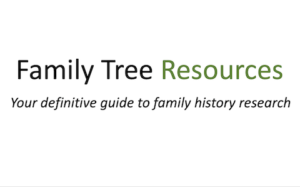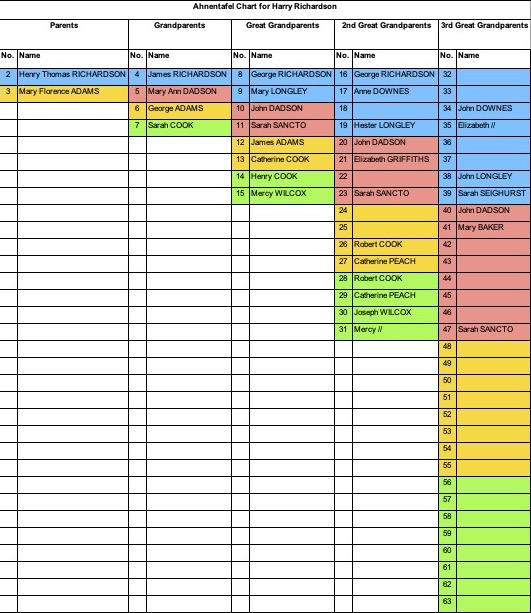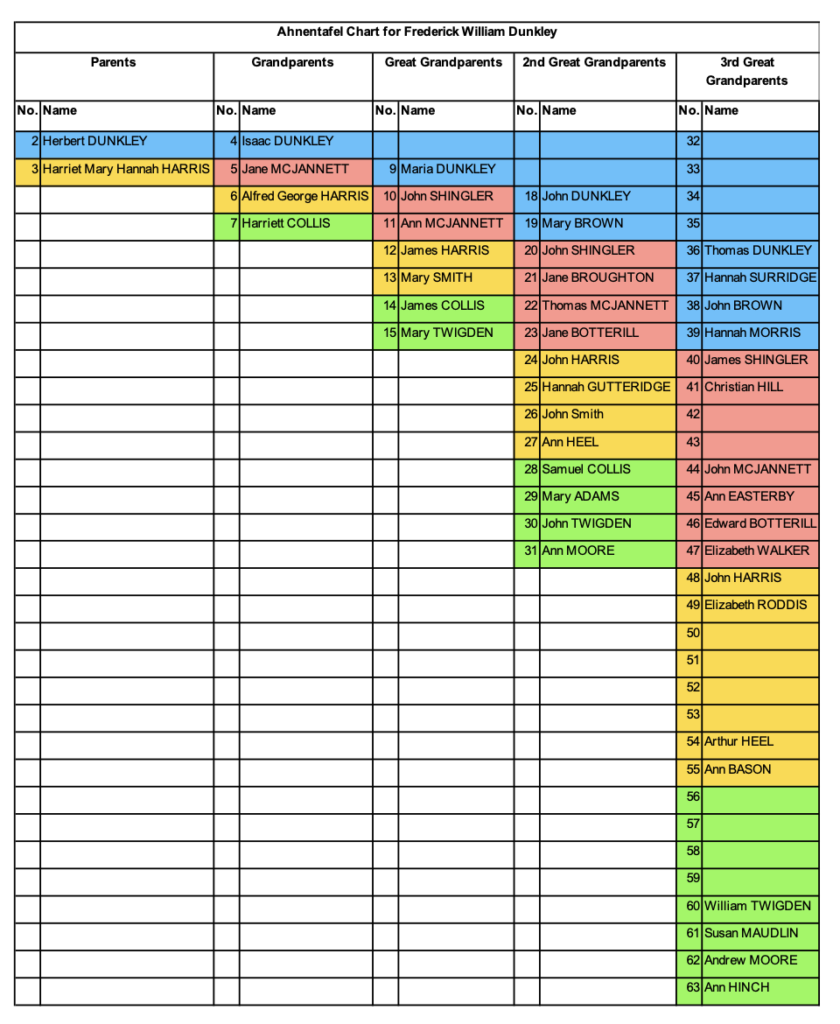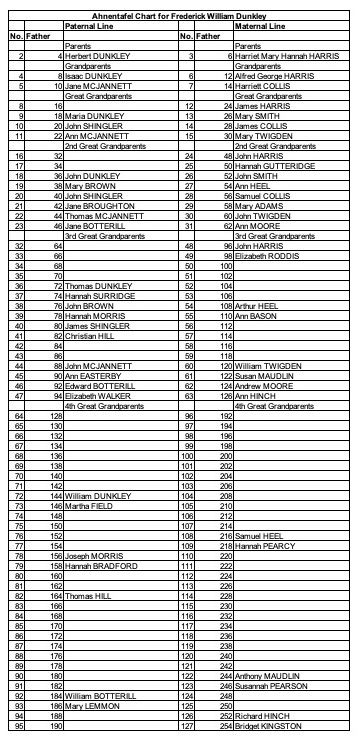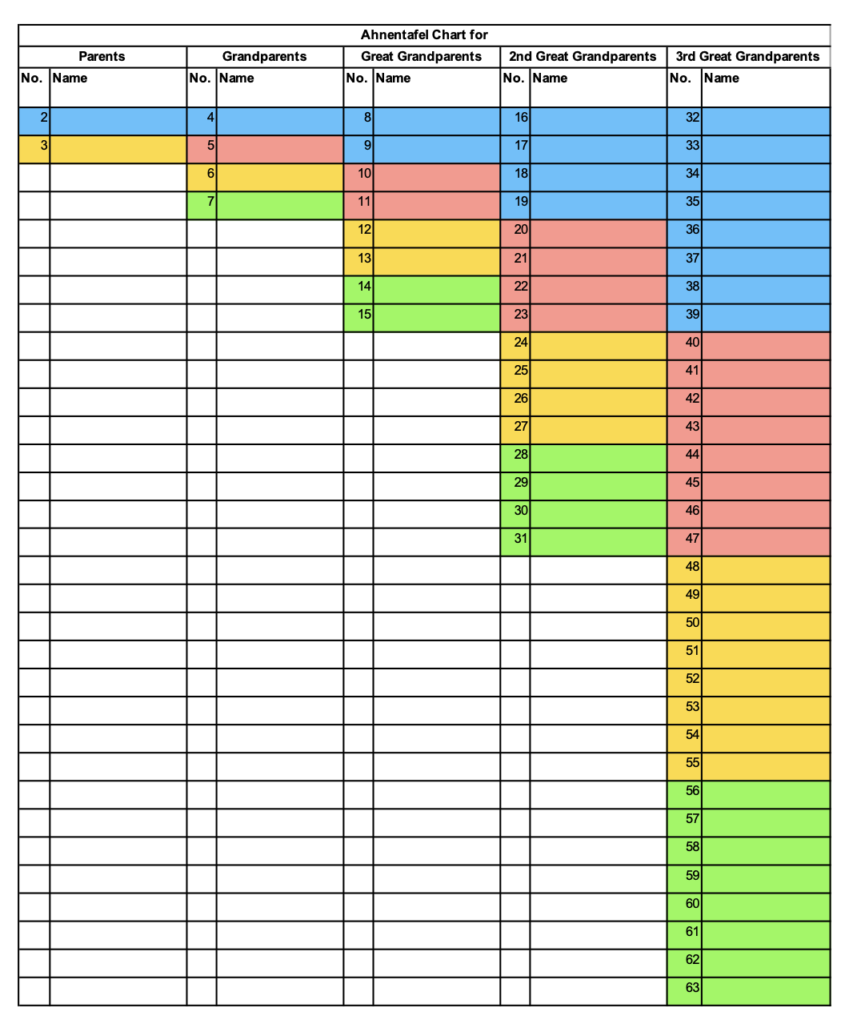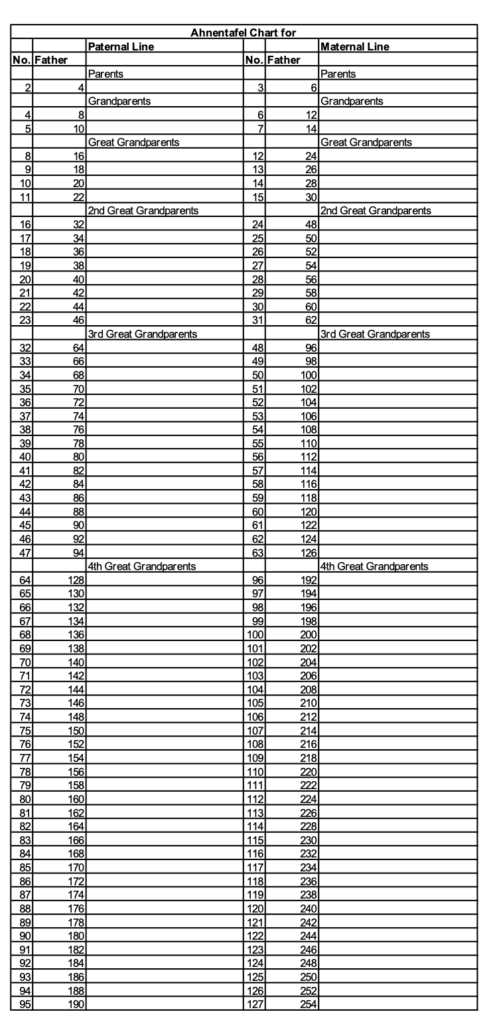An ahnentafel chart is a list of ancestors for any one individual. It is named after ahnentafel, which is German for ancestor table or pedigree. A standard numbering system is used to easily display how you are related to your ancestors.
You can easily see how any one specific ascendant is related to the first individual. It also makes it easier to understand family generations. If the information is known, it includes all the basic details such as full name, date and place of birth, date and place of marriage, and date and place of death.
How To Create An Ahnentafel Chart
An ahnentafel uses a specific numbering system to tell you how individuals are related to each other. Starting with yourself as 1, whether you are male or female, you have to double it to get to the next male ascendant, such as 2, 4, 6, 8, 10, 12, 14 etc. For your mother’s line, you should double this figure and add 1 to get 3, 5, 7, 9, 11, 13, 15, 17 etc.
Your mother would be 3 on your table, so her father would be 6 (3 x 2 = 6). Your maternal grandfather’s mother would be 13 ((6 x 2) + 1 = 13). Although you are labelled as 1, regardless of whether you are male or female, all male ancestors are listed with even numbers while female ancestors are listed with odd numbers.
The Ahnentafel Numbering System
I have created a table regarding each ancestor in your form up to you or your ancestor of choice’s great-grandparents.
| Number | Ancestor |
| 1 | Yourself or your ancestor of choice |
| 2 | Father |
| 3 | Mother |
| 4 | Paternal Grandfather |
| 5 | Paternal Grandmother |
| 6 | Maternal Grandfather |
| 7 | Maternal Grandmother |
| 8 | Paternal Grandfather’s Father |
| 9 | Paternal Grandmother’s Mother |
| 10 | Paternal Grandmother’s Father |
| 11 | Paternal Grandmother’s Mother |
| 12 | Maternal Grandfather’s Father |
| 13 | Maternal Grandfather’s Mother |
| 14 | Maternal Grandmother’s Father |
| 15 | Maternal Grandmother’s Mother |
The figures used in an ahnentafel chart are the same figures that are used in a pedigree chart. For more information about pedigree charts, please visit my article: pedigree charts in genealogy. You can also create family group sheets for each ancestor and their family unit.
If you have traced your family tree through many generations, and have used the numbering system, you can easily see how that person is related to the first person by working in reverse order. You take the ascendant’s figure, first seeing if it is odd or even.
If the integer is odd, the ascendant is female, so you subtract one and then divide by 2. If the integer is even, this ascendant is male, so you simply divide by 2. You keep following this method until you get back to 1.
For example, if you start with 15, you follow this method:
15 = mother
15 – 1 = 14/2 = 7 mother
7 – 1 = 6/2 = 3 mother
3 – 1 = 2 and 2/2 = 1 mother
As you can see by following this example, no. 15 is your mother’s, mother’s, mother.
Another example is if you were looking for no. 14:
14 = father
14/2 = 7 mother
7 – 1 = 6 and 6/2 = 3 mother
3 – 1 = 2 and 2/2 = 1 mother
No. 14 is mother’s mother’s father.
If you have traced your family tree back further than this, and have found an ascendant you have labelled as integer 40, you will find that this relation is your father’s, mother’s, father’s, father’s, father.
40/2 = 20 father
20/2 = 10 father
10/2 = 5 father
5 – 1 = 4 and 4/2 = 2 mother
2/2 = 1 father
No. 80 would be your father’s, father’s, mother’s, father’s, father’s, father.
If you would like to follow the paternal line, your ascendant’s numbers would be 2, 4, 8, 16, 32, 64, 128 and so on.
You can also use this calculator to find out which number relates to which ancestor.
Please remember when using the numbering system that although your male relatives are listed with even numbers and female relatives with odd numbers that this does not mean that even numbered ascendants are all on the paternal line and odd numbered ancestors on the maternal line.
You will obviously still have male ancestors on the maternal line and female ancestors on the paternal line.
How To Read An Ahnentafel Chart
An ahnentafel table only includes direct ancestors, so no siblings, aunts and uncles, and cousins are included. When looking at an ahnentafal table, whatever ascendant you are looking at, you simply double that figure to find that ancestor’s father, or double and add 1 to find that ancestor’s mother.
This is an example of an ahnentafel chart for my grandfather Harry Richardson:
- Harry Richardson
- Henry Thomas Richardson
- Mary Florence Adams
- James Richardson
- Mary Ann Dadson
- George Adams
- Sarah Cook
- George Richardson
- Mary Longley
- John Dadson
- Sarah Sancto
- James Adams
- Catherine Cook
- Henry Cook
- Mercy Wilcox
- George Richardson
- Anne Downes
- Unknown
- Hester Longley
- John Dadson
- Elizabeth Griffiths
- Unknown
- Sarah Sancto
- Unknown
- Unknown
- Robert Cook
- Catherine Peach
- Robert Cook
- Catherine Peach
- Joseph Wilcox
- Mercy //
- Unknown
- Unknown
- John Downes
- Elizabeth //
- Unknown
- Unknown
- John Longley
- Sarah Seighurst
- John Dadson
- Mary Baker
- Unknown
- Unknown
- Unknown
- Unknown
- Unknown
- Sarah Sancto
- Unknown to 63
If I was looking for the parents of Mary Ann Dadson using the list, I can see that they are John Dadson and Sarah Sancto because they are 10 and 11 in the list. Mary Ann Dadson was ancestor no. 5. You can obviously add as much information as you wish to your list, including birth, marriage and death dates and locations. Another way of displaying the details is to write the information into a table:
Writing the information in table format rather than as a list makes it a lot easier to see where you need to find more information. For example, in the table above I can see that I have yet to find information regarding the parentage of James Adams (no. 12). His parents would be 24 and 25 in the table.
Another example using the ancestry of my grandfather Frederick William Dunkley:
- Frederick William Dunkley
- Herbert Dunkley
- Harriet Mary Hannah Harris
- Isaac Dunkley
- Jane McJannett
- Alfred George Harris
- Harriett Collis
- Unknown
- Maria Dunkley
- John Shingler
- Ann McJannett
- James Harris
- Mary Smith
- James Collis
- Mary Twigden
- Unknown
- Unknown
- John Dunkley
- Mary Brown
- John Shingler
- Jane Broughton
- Thomas McJannett
- Jane Botterill
- John Harris
- Hannah Gutteridge
- John Smith
- Ann Heel
- Samuel Collis
- Mary Adams
- John Twigden
- Ann Moore
- Unknown
- Unknown
- Unknown
- Unknown
- Thomas Dunkley
- Hannah Surridge
- John Brown
- Hannah Morris
- James Shingler
- Christian Hill
- Unknown
- Unknown
- John McJannett
- Ann Easterby
- Edward Botterill
- Elizabeth Walker
- John Harris
- Elizabeth Roddis
- Unknown
- Unknown
- Unknown
- Unknown
- Arthur Heel
- Ann Bason
- Unknown
- Unknown
- Unknown
- Unknown
- William Twigden
- Susan Maudlin
- Andrew Moore
- Ann Hinch
As you can see from the reports for Frederick William Dunkley, I have traced his ancestry much further than that of my other grandfather, Harry Richardson. It is a shame that I do not think I will ever find out the true parentage of my ancestor Isaac Dunkley as the records are not available. I have my suspicions of who Isaac’s father could be, but have not been able to prove my theory.
Researching my family tree further back on the Dunkley side is one advantage of still living in the area the Dunkley’s and Harris’s came from!
I managed to find out the parentage of my other illegitimate ancestor Jane McJannett because a report was made in the Leicestershire Mercury that Jane’s father was John Shingler.
I have also designed a blank table of the chart above that you can download if you wish. As you progress with your table, you will notice that you have 4 grandparents, 8 great-grandparents, 16 great-great grandparents and 32 3x great-grandparents. Altogether, if you manage to trace them all, you will have 63 relatives including yourself and your parents.
I have created another blank table which makes it easy to distinguish your paternal line from your maternal line. I have also split it down between parents, grandparents, great grandparents, great-great grandparents, 3rd great grandparents and 4th great grandparents. I have stated the father’s number in the table as well as your ancestor’s own number so that it is easy to follow through the generations.
Advantages of the Ahnentafel Chart
One of the biggest advantages of the ahnentafel chart, even if you only choose to write down your ancestor’s names, and display the other pertinent information in another way, is that you can easily see where you need to continue your research.
As is shown by the example I created, I have still yet to find a lot of information about my grandfather Harry Richardson’s ancestors, which is easily displayed on the table.
If you have limited space in which to display your family tree, printing a list is a good idea because it can show a lot of information in a more compact format. Once you have understood the basics of an ahnentafel list, you will find that it becomes second nature to go from one person to their ancestors and back down the list again.
The numbering system is the biggest advantage to the ahnentafel system because you will notice that the father is always double the child’s, and the mother is always double the child’s plus one.
Drawbacks of an Ahnentafel Chart
In an ahnentafel chart, you may find that your ascendant is on your tree twice with different numbers. Robert Cook is numbered twice on my tree because he is the great-great grandfather of my grandfather Harry Richardson in two different ways.
James Adams married Catherine Cook, and had George Adams. Henry Cook married Mercy Wilcox and had Sarah Cook. Catherine Cook and Henry Cook were brother and sister – their father was Robert Cook. George Adams and Sarah Cook married each other although they were first cousins because they shared the same grandfather, Robert Cook.
George and Sarah had Mary Florence Adams, who in turn married Henry Thomas Richardson and had my grandfather Harry Richardson. For more information about how family trees work with cousins, please read my article: how do family trees work with cousins?
If you assign a number to your ancestor and then find that information is incorrect, you would then have to reassign numbers for those people and their ancestors.
Another drawback is that having only a list of ancestors may be confusing to people just starting their research journeys. It does not explain how people are related to each other without doing a lot of mathematical calculations.
If you are working on another family member’s tree, such as your cousin’s, it does not necessarily follow that although you have some of the same ancestors your cousin’s tree will be the same as yours. If your cousin is the child of your father’s sister, your paternal grandparents will be your cousin’s maternal grandparents, and so therefore your cousin’s tree will be numbered differently.
The one problem with using a table is that if you wish to add more information such as birth, marriage and death dates and locations is that you could end up using several sheets of paper if you choose to print if off, which could lead to confusion.
Printing off the table is fine if you have only traced your tree back to your great-grandparents or great-great grandparents, but if you have traced further back than that, and have many generations to display, you will probably not be able to print the table on standard size paper if you wish to show more details about your ascendant’s besides their names.
The number of ancestors you have will double each time you find a new generation. It is fine if you only go back to your 3x great grandparents, which amounts to 64 ancestors, which can still fit on to standard size paper, but if you go back further, you will soon find that you have 128 ancestors in the next generation, and 256 ancestors in the next. It is easy to see that it will become very difficult to fit these numbers of ancestors on to even a3 size paper.
Conclusions
I can easily see why the ahnentafel chart can be used to display your genealogy, but personally I believe that using a pedigree chart is a much better way of sharing your research with other people and to see where you need to conduct more research.
Whichever way you choose to display your research, whether that is by using an ahnentafel chart or pedigree chart, I hope you enjoy your research journey and sharing your tree with other people.
